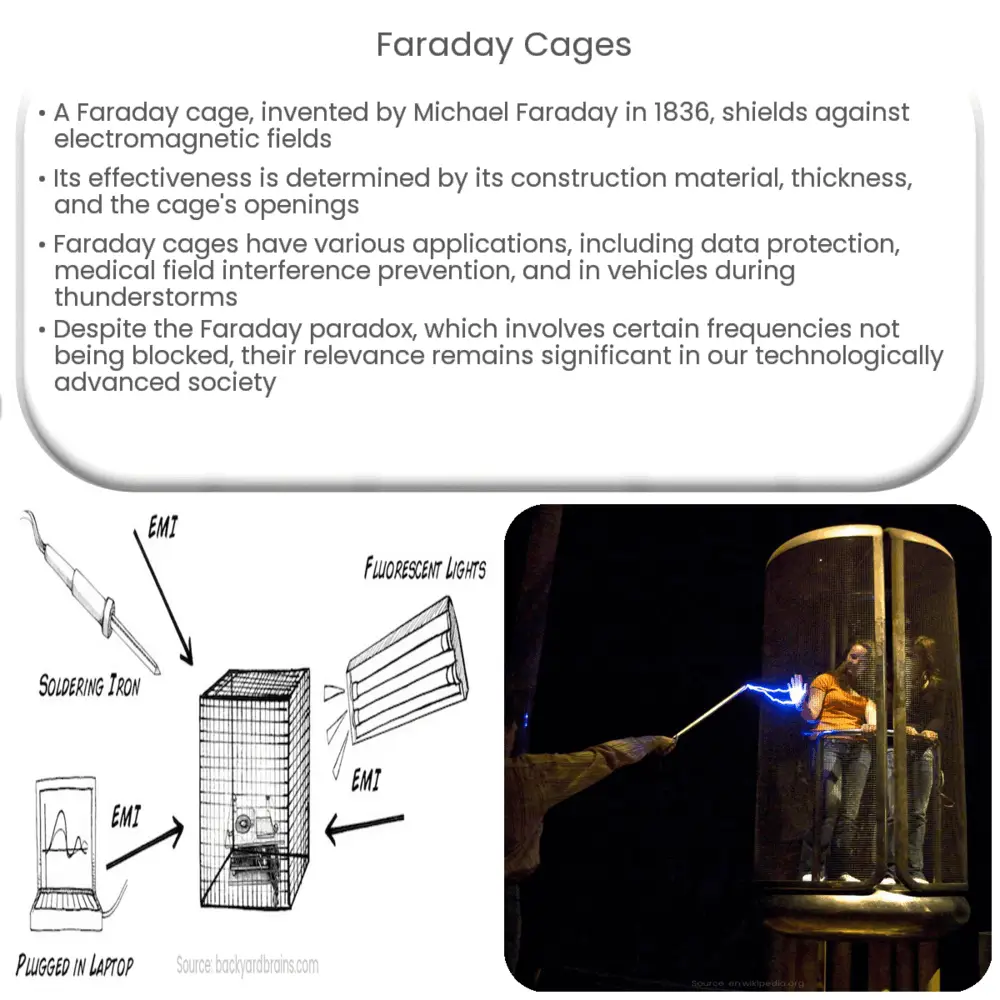Explore the intriguing world of Faraday cages, their applications in various fields, and their critical role in data security and electromagnetic shielding.

Introduction to Faraday Cages
A Faraday cage, named after the influential scientist Michael Faraday who invented it in 1836, is a shield against electromagnetic fields. It is an enclosure formed by conductive material or by a mesh of such material, which protects anything within from external static and non-static electric fields.
Functioning of Faraday Cages
Understanding how a Faraday cage works involves exploring the fundamental principles of electromagnetism. When an external electrical field strikes the cage, the electrons within the cage’s material are forced to move. This movement of electrons cancels out the field’s effects within the cage, thus creating a zone shielded from external electric fields.
Applications of Faraday Cages
The Science Behind Faraday Cages
The effectiveness of a Faraday cage is determined by its construction – the material it’s made from, the thickness of that material, and the size of the openings in the cage. Faraday’s law of electromagnetic induction states that the electromagnetic waves are absorbed and redistributed by the conductive material of the cage, negating the field’s impact within the enclosure.
The Faraday Paradox
The Faraday paradox, however, adds complexity to the subject. It refers to a particular condition where a Faraday cage behaves differently than expected. This peculiar behavior involves the cage’s inability to block certain frequencies, particularly those on the lower end of the electromagnetic spectrum, which is a crucial aspect to explore.
Understanding the Paradox
The paradox can be understood by considering the relationship between the size of the cage’s holes and the wavelength of the incoming wave. When the cage’s holes are significantly larger than the wave’s wavelength, the cage effectively blocks the wave. However, if the hole sizes are around the same size as the wave’s wavelength, the cage’s ability to block the wave decreases.
Modern Faraday Cages
In recent years, the utility of Faraday cages has been significantly expanded in line with our increasing dependence on electronics. The ever-growing demand for data privacy and the protection of electronic devices from electromagnetic interference has driven innovation and optimization in Faraday cage design. Modern-day Faraday cages range from simple mesh enclosures to highly sophisticated, layered systems integrated with cutting-edge materials and technologies.
Importance in Data Security
Faraday cages play a pivotal role in data security, preventing unauthorized access to information on electronic devices. They are frequently used in secure facilities to protect sensitive information from external snooping or data leakage. Data centers also utilize Faraday cages to protect servers from external electromagnetic disturbances that could disrupt operations.
Usage in Research and Academics
Furthermore, Faraday cages are an invaluable tool in academic and research settings. They allow for experiments to be conducted without the interference of external electrical fields, providing controlled environments for high precision measurements and observations. They are widely used in physics, engineering, and biological research labs around the world.
Faraday Cages in Everyday Life
Interestingly, Faraday cages also permeate our everyday life, often without us realizing it. For instance, the concept of a Faraday cage is implemented in microwave ovens to prevent the escape of microwaves. Elevators and certain types of vehicles also function as Faraday cages, providing protection from external electromagnetic fields.
Conclusion
In conclusion, Faraday cages are a critical component of our technologically advanced society. From protecting sensitive electronics and data to facilitating ground-breaking research, these enclosures form an integral part of our daily lives and the operations of various industries. Despite their inherent paradox, they continue to prove their value and versatility in the face of changing technologies and emerging challenges. As we continue to explore the realm of electromagnetism, the role of Faraday cages remains as relevant today as when they were first conceived by Michael Faraday in the 19th century.

